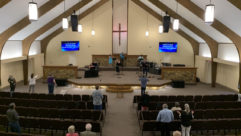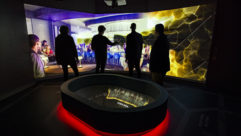THE MOST BANG UNDER BUDGET
Jan 1, 2001 12:00 PM,
By Cal Perkins
In almost every article I have read in trade publications aboutinstalled church sound systems, the size of the system suggeststhat the budget for the materials and labor is in excess of mostpeople’s annual compensation. Each house of worship has its ownunique sound system requirements that depend on the congregation’sstyle of worship and the building architecture. In this article,I’ll focus on the requirements for the smaller church congregationsof up to 500 people. Specifically, I’ll concentrate on good systemsthat can be purchased and installed for a cost of between $1,800and $10,000.
KNOW YOUR CUSTOMER
In the U.S., the average congregation size ranges from 100 toabout 200 people, depending on denomination and geographiclocation. In most of these small congregations, as well as in newchurch startups, the sound system budget can be somewhat limited.In fact, most of the small church business is invisible to theaverage sound contractor. Why?
Several years ago, a rather comprehensive national market surveysponsored by a major equipment manufacturer was done on the smallP.A. market. A surprising discovery of the survey was that almostall first-time purchases of small systems are made at the retaillevel and that retail music stores are unaware of the volume ofbusiness they sell into the institution market. The median streetprice for an “acceptable” entry-level P.A. system thatincludes two microphones, mic stands, power mixer and two 15-inch,2-way speakers is around $1,700. When this equipment fails to meetthe expectations of the users, or technical problems arise that arebeyond the scope of the users, either a contractor or a repairtechnician is sought out to resolve the problems. Unfortunately,this places the contractor in the awkward position of having todeliver the bad news that the cheap-system solution really isn’t asolution at all.
An interesting side note of the extensive market survey was thatafter the “recommended” entry-level system waspurchased by the market research firm and used over a period oftime for various applications, it was obvious to all involved thatan upgrade was necessary.
How can you, as a contractor, circumvent the aforementionedscenario? The secret is to know your market and its requirements. Agood way to gather information is to attend the weekend services atlocal houses of worship and see for yourself.
BASIC EQUIPMENT REQUIREMENTS
Each faith and/or denomination has its own style of worship andchurch government (who signs the checks). Regardless ofdenomination and style of worship, one thing is common: the spokenword. From there, there is a wide divergence of worship styles andrequirements, and herein lies the technical and politicalchallenge. A good example of such diversity can be seen incomparing the musical requirements of a conservative, mainlinecongregation with that of a southern gospel church. Equally diverseare the styles and loudness of traditional and contemporaryservices. Style and loudness are important issues. A budget soundsystem that runs out of headroom, distorts easily and has a skewedspectral balance only exacerbates the problem of “it’s tooloud!” Ideally, the system should handle any type of servicewithin a limited budget.
Starting with a basic thumbnail sketch at the input side of thesystem, one will need one or more microphones, a cassette recorderand a CD player. Allow about $150 for the CD player and cassetterecorder (a good duplication cassette deck runs about $300).
In most applications the vocal and instrument microphones arestandard dynamic. Choir pickup is usually best covered by condensermicrophones, and the clergy may prefer small lavalier (tie-clip)microphones for freedom of movement. If the budget allows, awireless system will set the pastor free. However, the small cablesand connectors used in the lavalier microphones for both wired andwireless operation are maintenance hassles as the cables are alwaysbreaking at either the microphone end or the connector end. The oldadage, “he who has spares has no cares,” applies tomini-mics. Plan on budgeting at least $75 to $150 per dynamicmicrophone, $200 to $500 for good condenser microphones and $500 to$1000 for a versatile wireless system.
Since it is highly unlikely that the budget will allow forprofessional cassette decks or CD players, many houses of worshipwill end up purchasing consumer grade units. Often, thecongregational members will want a tape of a particular service, soit would be advisable to get at least one duplicating cassettedeck. Because of the tape recorder monitoring loop, it is goodadvice to buy two decks and avoid any possibility of feedbackwithin the mixing console due to operator ignorance or error. Onedeck should be dedicated for playback only, the other for recordingonly, thus making it impossible to send the system off intoultrasonic feedback that will result in either blowing up the poweramplifiers or the high-frequency drivers.
Mixer Requirements. First, to best determine the number ofmicrophone input channels that will be needed, let’s review some ofthe possibilities. In order of relative importance we have:
As you can see, a mixer with eight microphone inputs does notallow for much in the way of expansion, but it will handle theminimum requirements if there are additional line-level inputspresent. At the other extreme, we are looking at 24 microphoneinput channels to handle everything.
Second are the stereo line-level input requirements. Since musicis an integral part of many worship services, stereo playback forboth cassettes and CDs are frequently used. It is quite common in aservice for a member to sing along with a pre-recorded instrumentalbackground. The stereo input requirements are one each of thefollowing: stereo cassette, CD Player, keyboard input, and a stereovideo input.
If one doesn’t mind unplugging equipment, only one stereo inputis needed, but for convenience two or more is preferable.
Third is the number of auxiliary sends per channel formonitoring and signal-processing effects. Typically, the“Auxiliary Send” mix has the signal routed offpre-fader, while the “Effects Send” operatespost-fader. Basic requirements are 1 to 2 sends/inserts/returns(effects for signal processing) and 1 to 6 sends (monitor mix). Thebare minimum requirement is one effects channel and one auxiliarychannel send.
Fourth, the mixer should have both left and right RCA tapeoutputs for recording the service and, preferably, balanced stereooutputs and a balanced mono output. These requirements can befilled with a typical 6-to-8-channel mono- or stereo-poweredmixer.
The system will be missing the pre-fader Cue/Solo functions thatallow the operator to cue up songs on the CDs or cassettes, channelmute buttons, and functions that allow sub-groups to be mixed (likegrouping all instruments or all vocals). These features are foundin most stand-alone and high-cost powered mixers.
Powered & Unpowered Mixers. If you choose a powered mixer,you may need an additional power amplifier for stage monitors.Powered mixers designed with two separate mono amplifiers that canbe configured for either main or monitor operation can eliminatethe need for a separate monitor power amp, however the main mixwill be run in mono. Expect to spend $650 to $1,000 for a poweredmixer. Eight to 24 input mixing consoles range in price from $600to $2,000. There are also some very cost-effective mixers withbuilt-in effects that are perfect for small church systems (under$900 for 16 mic inputs, four line inputs).
For more flexible systems, a non-powered mixer is usuallyselected. With such a system, one is faced with either choosing theappropriate power amplifier and speaker combinations or eliminatingthe power amplifiers and electing to use the newer powered speakersystems. I am partial to the powered speakers for cost, performanceand system reliability, but there are valid arguments for poweredamplifiers and passive speakers. Over the past five years, theindustry has exploded with many powered P.A. speaker systemofferings, chiefly due to better design for sound quality, ease ofuse, and portability. Speaker selection is critical because it isvery easy to make the selection on price alone, not on performance.If passive speakers are selected, expect to spend at least $500 to$600 per speaker and $450 to $700 for the power amplifiers.Excellent powered speakers are priced between $650 and $900 each.Remember that if you use powered speakers, the P.A. system will notneed a compressor/limiter for system protection. A loud, sustainedblast of high-frequency acoustic feedback and a big power amplifierwill take out the high-frequency diaphragm in the compressiondriver if a compressor is not used to protect a non-self-poweredspeaker system. It is interesting to note that the cost of twopowered speakers is about the same as it is for the discrete poweramplifier and speaker combination, but with very little built-inprotection.
Flat system power response is essential for good intelligibilityand is more desirable than alleged extended bandwidth as shown inFigure 2. Note in the top graph that the frequency response issmooth both on and off axis, whereas in the bottom one there is alarge power hole in the system response when one moves off axis.This system has a more hi-fi, up-front sound if — and only if— one is directly on axis; however, vocal articulationsuffers in a reverberant environment.
Outboard Gear. I am sure many readers have noticed theconspicuous absence of any mention of signal processing equipmentsuch as equalizers, digital effects and compressors. It has been myexperience (reinforced by the P.A. market study) that the inclusionof compressors and equalizers can and do cause more harm than goodwhen placed in the hands of inexperienced personnel.
CONGREGATIONAL SIZE AND SPACE
Church Startup. New church start-ups begin in a number of ways.The smallest is a gathering in a private home that grows to thepoint that larger facilities are needed to accommodate theadditional members. Other startups are church plantings from anestablished body of believers. Usually, the congregation meets insome type of private local hall, business auditorium, schoolfacility, funeral chapel or other civic facility. When thecongregation is using borrowed facilities, the contractor is stuckwith the existing room acoustics and must work around them. The newcongregation in a facility situation like this is forced to set upand tear down their service each week. This involves setting up thechairs, the sound system and any musical instruments. Here, we aredealing with the classic portable system. With a little intelligentplanning, almost all of the equipment can be used as thecongregation grows. Remember that one of the most importantattributes of a portable sound system is the number of trips to andfrom the van or truck. Would you rather move two 80-to-100-poundspeaker boxes and a 30-to-50-pound amplifier rack or two 40-to-50pound powered speakers?
Usually a system consisting of four microphones, a powered mixerand two speakers on speaker stands is best for startup churches.Such a system does not allow for future growth, although it can bepurchased for under $2,000 with little or no technical support. Abetter system for a startup might consist of two powered speakers,two speaker stands, one cassette recorder and a CD player in aportable case, a small 8-to-16 input channel mixer, microphones,stands and cables. Depending on the powered speakers selected, thesystem should easily meet SPL and coverage needs of any type ofservice. Since it is likely that there are fewer than 100congregation members, it will not be necessary to mike a 60-voicechoir and have a 24-channel mixer. A target budget for such asystem would land somewhere around $3,500 for everything.
Multipurpose Facilities. As the congregation grows, its membersbegin to look for a permanent home. They begin to think about thefirst phase of a building project. Good stewardship predicates thatthe building maximizes its utility because there are seldom enoughfunds to do everything at once. Therefore, many congregations optto build a multipurpose worship space that can also serve as ameeting hall for meals, special programs and sport activities. Ionce visited such a place where the window casings were less thanone standard volleyball width to prevent glass breakage when usedas a gym, yet provided sufficient light for the Sunday morningservice. So if a multipurpose facility is used and the speakershappen to be permanently installed, protection against flyingobjects would be advisable.
A small facility may occupy 900 square feet of floor space (30feet by 30 feet or so) while most small spaces will hold around 100to 150 people seated (50 feet by 60 feet, minimum). If the worshipspace has a regulation-sized basketball floor, the dimensions willbe in excess of 55 feet by 110 feet, which is a area large enoughto seat 450 to 550 people. This is no longer a “smallchurch.” To promote a more intimate worship environment, manybuildings adopt an architecture where the width of the building isapproximately twice its length. In such cases, the speaker systemis called on to cover at least 150 to 180 degrees of coverage. If acentral cluster is used, this may require at least three systemswith 60 to 90 degree coverage angles. Remember that we arediscussing small, packaged systems here and not complex speakerarrays made of discrete hardware. In some acoustic environments, itmay make more sense to use only two speakers on either side of thechancel area, as would be typically done in the portable case. Inmany cases, there is very little acoustic treatment in the roomand, due to excessive reflections, it is too live. Simple acoustictreatment can be added to the room economically by suggesting theuse of 3-inch-thick Owens Corning 703 fiberglass batts, coveredwith a suitable fabric and framed with a simple wood frame forplacement on the walls. One must continually keep in mind that theoperational budget of the church is probably between $50,000 and$250,000 per year, so funds are tight.
YOUR ROLE AS CONTRACTOR
If you are lucky enough to be involved in the planning phases ofthe building project, suggest that sufficient sound, video andtelecom cable be pulled while it is easy and inexpensive to do so.Whatever you do, don’t skimp on the microphone signal cable! Thereare, unfortunately, several brands of cables that exhibit up to a15% to 20% unbalance in cable capacity from conductor to shield forthe signal conductors due to cheap construction. If the cable runsare long, this unbalance in conductor-to-shield capacity willencourage RFI detection in most of the transformerless microphoneinput stages in the mixers currently on the market. Also of extremeimportance is make sure that the sound system gets its owndedicated AC service that does not have a shared neutral withanother service! Perhaps one of the most overlooked (and mostmisunderstood) technical issues is the proper AC power distributionfor the system. Since the system will no doubt integrate both3-wire safety-grounded equipment and 2-wire equipment withunbalanced inputs and outputs, proper AC power sequencing isessential. Again, see Figures 1a and 1b for the most basicconcepts. It is essential that all of the small signal equipmentderive its power from the same power strip. If there are remotelylocated power amplifiers, then a balanced I/O should be usedbetween the mixer and the power amplifiers or powered speakers.
Designing and installing the system is the easy part. Determinethe equipment requirements, work within the budget and close thesale. The single most important issue is realizing that, in almostevery case, the sound system operator is a part-time volunteer, nota professional. Therein lies the root of most system problems. Thefield of knobs on the mixer often intimidates operators, as theyreally do not understand the system architecture. After all, if thewrong knob is turned, the resulting blast of feedback is veryembarrassing. It is in the education and documentation phases ofthe project where the services of a professional will ensuresuccessful equipment use. You are selling your service, not justequipment. Be prepared to spend a fair amount of time on thesephases of the project. A common problem many church systems face isa not having a quick and easy “Return-to-Zero” initialsetting chart to refer to when the sound system is readjusted byunsupervised helpers. The operator needs a map of the initialsettings for the console and other equipment. This is one of thereasons why including a graphic equalizer or a compressor can bedangerous. If they are included in the system, some type ofsecurity cover must be used or the units will become misadjusted byeither the church’s helpers or by the operational personnel.
Cal Perkins is the Technical Director at Mackie Designs. Contacthim at [email protected].










